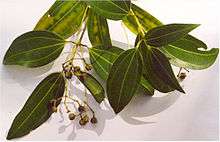Cinnamomum verum
| Cinnamomum verum | |
|---|---|
 | |
| Cinnamomum verum foliage and flowers | |
| Scientific classification | |
| Kingdom: | Plantae |
| Clade: | Angiosperms |
| Clade: | Magnoliids |
| Order: | Laurales |
| Family: | Lauraceae |
| Genus: | Cinnamomum |
| Species: | C. verum |
| Binomial name | |
| Cinnamomum verum J.Presl | |
| Synonyms | |
| |
Cinnamomum verum,[2] called true cinnamon tree or Ceylon cinnamon tree is a small evergreen tree belonging to the family Lauraceae, native to Sri Lanka.[3] Among other species, its inner bark is used to make cinnamon.
The old botanical synonym for the tree—Cinnamomum zeylanicum—is derived from Sri Lanka's former name, Ceylon.[4] Sri Lanka still produces 80–90% of the world's supply of Cinnamomum verum, which is also cultivated on a commercial scale in the Seychelles and Madagascar.[5]
Cinnamomum verum trees are 10–15 metres (30–50 feet) tall. The leaves are ovate-oblong in shape and 7–18 cm (3–7 inches) long. The flowers, which are arranged in panicles, have a greenish color and a distinct odor. The fruit is a purple 1-cm drupe containing a single seed.
Cultivars
There are several different cultivars of Cinnamomum verum based on the taste of bark:[6]
- Type 1 Sinhala: Pani Kurundu (පැණි කුරුඳු), Pat Kurundu (පත් කුරුඳු) or Mapat Kurundu (මාපත් කුරුඳු)
- Type 2 Sinhala: Naga Kurundu (නාග කුරුඳු)
- Type 3 Sinhala: Pani Miris Kurundu (පැණි මිරිස් කුරුඳු)
- Type 4 Sinhala: Weli Kurundu (වැලි කුරුඳු)
- Type 5 Sinhala: Sewala Kurundu (සෙවල කුරුඳු)
- Type 6 Sinhala: Kahata Kurundu (කහට කුරුඳු)
- Type 7 Sinhala: Pieris Kurundu (පීරිස් කුරුඳු)
Gallery
- Leaves of the Cinnamomum verum plant
- Leaves of the Cinnamomum verum plant
 Bark, powder and dried flowers from Cinnamomum verum plant
Bark, powder and dried flowers from Cinnamomum verum plant
References
- ↑ http://www.theplantlist.org/tpl/record/kew-2721692
- ↑ "NCBI - Cinnamomum verum". National Center for Biotechnology Information. Retrieved 4 October 2016.
- ↑ "Cinnamon". Encyclopædia Britannica. 2008.
(species Cinnamomum zeylanicum), bushy evergreen tree of the laurel family (Lauraceae) native to Bangladesh, Sri Lanka (Ceylon), the neighboring Malabar coast of India, and Myanmar (Burma), and also cultivated in South America and the West Indies for the spice consisting of its dried inner bark. The bark is widely used as a spice due to its distinct odor.
- ↑ "In pictures: Sri Lanka's spice of life". BBC News.
- ↑ Iqbal, Mohammed (1993). "International trade in non-wood forest products: An overview". FO: Misc/93/11 - Working Paper. FOOD AND AGRICULTURE ORGANIZATION OF THE UNITED NATIONS. Retrieved November 12, 2012.
- ↑ http://www.exportagridept.gov.lk/web/index.php?option=com_content&view=article&id=128&Itemid=159&lang=en
Further reading
Mathew, Sindhu; Abraham, Emilia (March 2006). "Studies on the antioxidant activities of cinnamon (Cinnamomum verum) bark extracts, through various in vitro models". Food Chemistry. 94 (4): 520. doi:10.1016/j.foodchem.2004.11.043.
External links
http://www.trueceylonspices.com/ceylon-cinnamon/
| Wikimedia Commons has media related to Cinnamomum verum. |